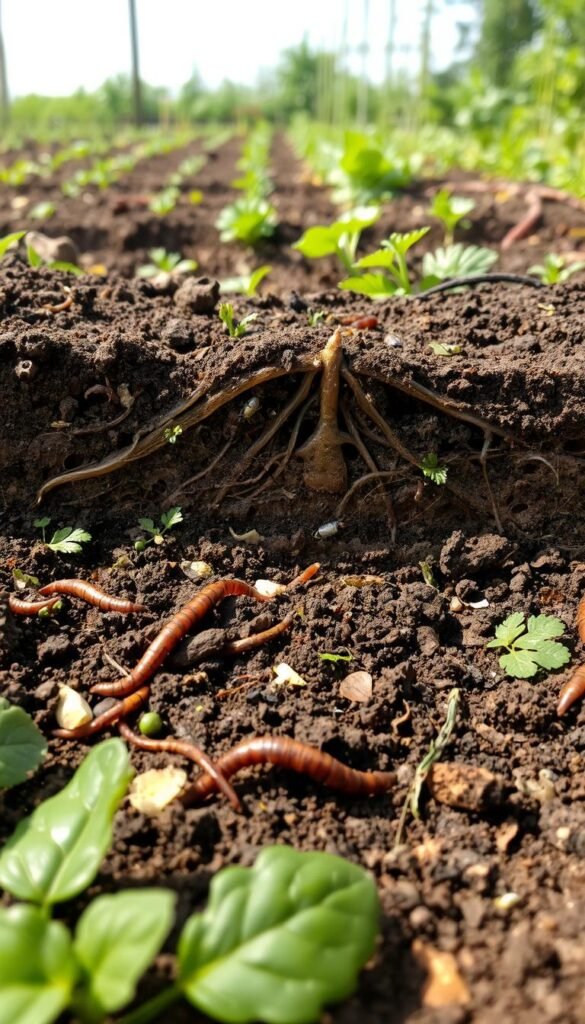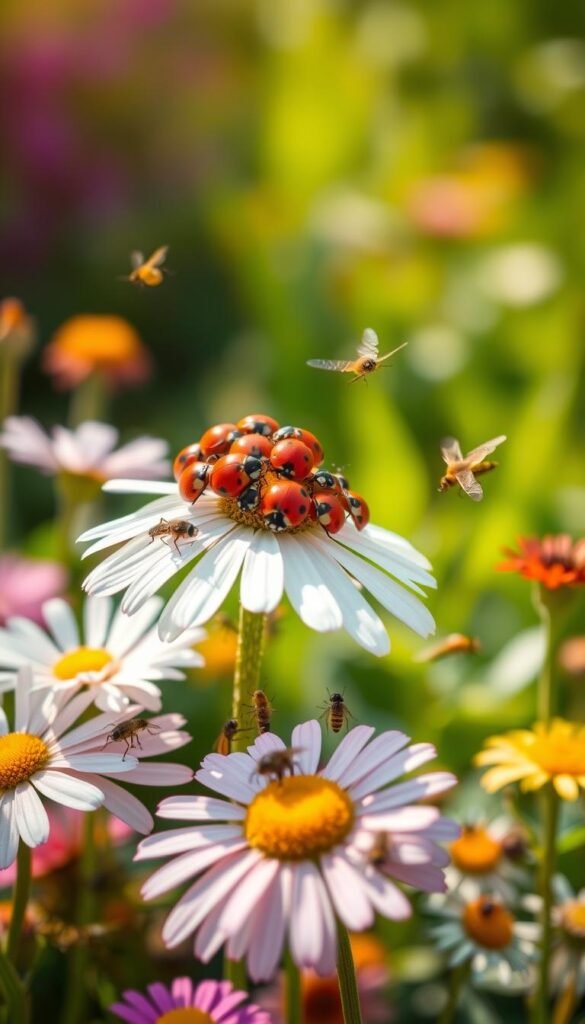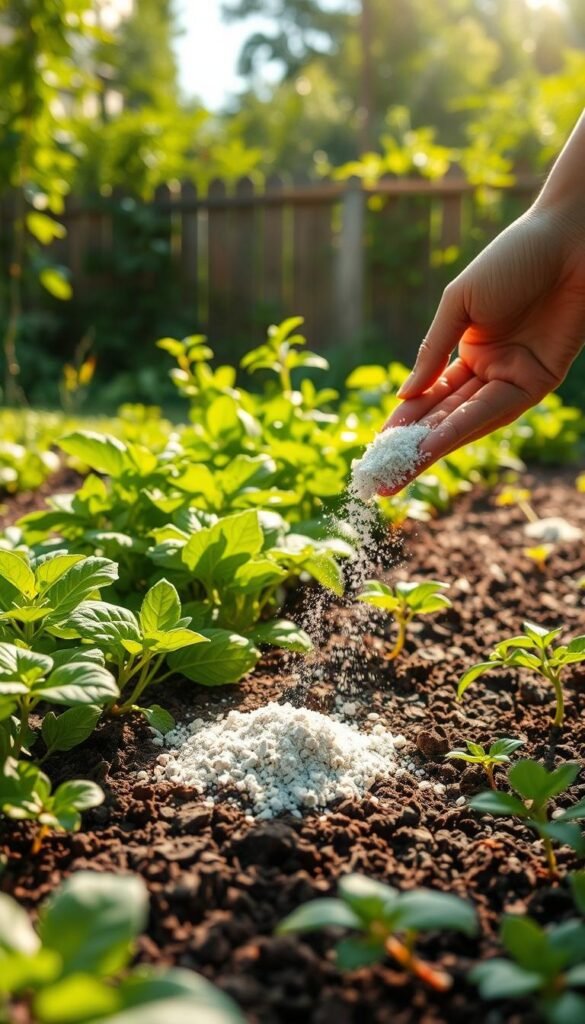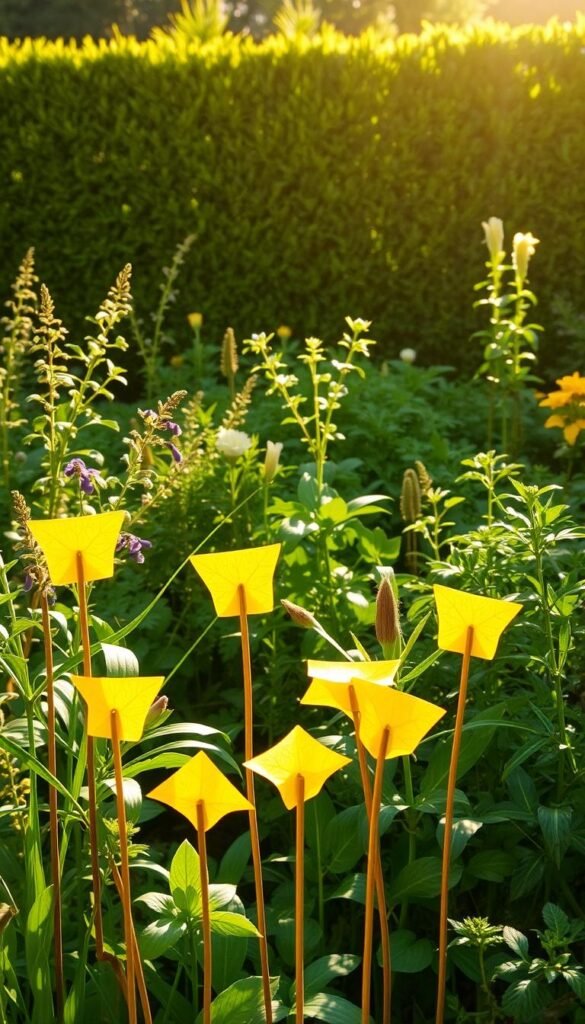Growing healthy plants without harsh chemicals is easier than you think. A well-balanced garden ecosystem naturally resists pests while keeping your soil alive. This approach saves time, money, and the environment.
No-till methods protect underground helpers like earthworms and microbes. These tiny allies strengthen plant roots and fight off invaders. Many gardeners report fewer beetle problems after adopting these practices.
Simple changes make a big difference. Companion planting creates natural defenses, while homemade sprays tackle issues gently. For example, basil near tomatoes wards off flies, and neem oil stops mites without harming soil.
Want to learn more? Discover eco-friendly pest control solutions that work in small spaces too. Your garden will thank you – and so will the butterflies!
Why Natural Pest Control Matters in No-Till Gardens

Your garden’s defense system starts beneath your feet—in the soil. Unlike chemical sprays that create temporary fixes, building healthy earth creates lasting protection against pests. Research shows plants grown in organic soil have 60% higher pest resistance, forming their own biochemical defenses.
The link between healthy soil and pest resistance
Every teaspoon of undisturbed soil contains billions of microbes that act as your plants’ immune system. These microscopic allies:
- Produce antifungal compounds that deter harmful insects
- Help plants absorb nutrients for stronger cell walls
- Break down organic matter into pest-fighting minerals
A study by the Audubon Society found that home gardens use three times more pesticides per acre than farms. By contrast, no-till systems increase earthworm populations by up to 300%, creating natural aeration that drowns pest larvae.
How no-till gardening reduces pest habitats
Turning soil might seem helpful, but it actually creates perfect conditions for pests. When you avoid tilling:
- Predatory insects maintain stable hunting grounds
- Fungal networks remain intact to suppress diseases
- Slugs avoid seaweed-mulched beds (they hate the salt content)
Japanese beetle grub counts drop by 40% in undisturbed gardens, according to University Extension research. For best results, combine these practices:
- Annual compost applications
- Three-year crop rotations
- Always source certified disease-free transplants
Simple soil tests help maintain optimal nutrient balance—your first line of defense against pests seeking weak plants. Remember, prevention starts underground!
Preventing Pests Before They Arrive
Smart gardening starts with proactive steps. By focusing on prevention, you create an environment where plants thrive and pests struggle to gain a foothold. Simple daily habits make all the difference.
Building resilient plants through organic soil
Healthy plants begin with nutrient-rich earth. Test your soil with this easy mason jar method:
- Fill a jar halfway with soil
- Add water until nearly full
- Shake vigorously for 30 seconds
- Let settle for 24 hours
Layers will show your soil composition. Aim for 40% sand, 40% silt, and 20% clay. Balanced soil prevents weak growth that attracts aphids.
Smart planting: Crop rotation and interplanting
Rotate your crops yearly to confuse pests. Studies show this breaks their life cycles 89% of the time. Try these powerful plant pairs:
- Tomatoes + basil (repels hornworms)
- Cucumbers + garlic (deters beetles)
- Lettuce + chives (masks scent from pests)
- Beans + marigolds (reduces pests by 33%)
Space plants properly to allow airflow. This prevents mold and discourages weak-flying insects.
Morning watering and dry foliage tips
Water at 7 AM to give leaves time to dry. Damp foliage overnight invites slugs and fungi. Drip irrigation cuts pest-friendly moisture by 40%.
Set up your system correctly:
- Place emitters 12-18 inches apart
- Run for 30-45 minutes in morning
- Adjust based on weather conditions
For more gardening tips, explore our guide on organic pest control for beginners.
Using Natural Pest Deterrents: Beneficial Insects as Allies

Your best pest controllers have six legs and don’t charge a dime. These beneficial insects form nature’s defense team, working around the clock to protect your garden. By understanding their roles, you can create an ecosystem where predators outnumber pests.
Ladybugs and lacewings for aphid control
A single lacewing larva devours 200 aphids weekly, while adult ladybugs consume 50 daily. These predators target soft-bodied pests that damage leaves and stems. For best results:
- Release purchased ladybugs at dusk (1,500 per 1,000 sq ft)
- Provide shallow water sources with pebbles
- Avoid spraying during peak activity hours
Parasitic wasps for caterpillar management
Umbelliferae flowers like dill and fennel attract tiny wasps that control caterpillars. These beneficial insects lay eggs inside pests, stopping damage naturally. Research shows gardens using this approach see 50% fewer outbreaks within two seasons.
Creating a mini insectary with pollinator plants
Boost predator populations by 70% with these top insectary flowers:
- Yarrow (Achillea millefolium)
- Goldenrod (Solidago spp.)
- Cosmos (Cosmos bipinnatus)
- Alyssum (Lobularia maritima)
- Dill (Anethum graveolens)
| Season | Active Predators | Target Pests |
|---|---|---|
| Spring | Ladybugs | Aphids, mites |
| Summer | Lacewings | Thrips, mealybugs |
| Fall | Hoverflies | Whiteflies, scales |
For more strategies, explore our guide on organic pest control solutions that complement these natural allies. Remember, a diverse garden creates its own protection!
DIY Organic Sprays for Common Garden Pests

Your kitchen holds powerful ingredients for pest control. With just a few household items, you can create effective sprays that stop invaders without harming your plants or soil. These solutions work with nature’s chemistry to solve problems before they escalate.
Soap-and-oil spray for soft-bodied insects
This classic combo suffocates aphids, mites, and whiteflies on contact. The soap breaks down their protective coating while the oil blocks their breathing pores.
Mix this recipe in a spray bottle:
- 1 tablespoon pure castile soap (like Dr. Bronner’s)
- 1 tablespoon canola or sunflower oil
- 1 quart warm water
Always test on a few leaves first. Avoid using on hot days or sensitive plants like peas and ferns.
Garlic-pepper repellent for beetles
Japanese beetles and cucumber beetles hate this pungent mix. Research shows it reduces damage by 65% when applied weekly.
Blend together:
- 10 garlic cloves
- 2 hot peppers
- 1 quart water
- 1 teaspoon vegetable oil
Strain before spraying, focusing on the undersides of leaves where pests hide.
Neem oil: When and how to apply
Cold-pressed neem oil disrupts pests’ life cycles without harming bees when used properly. It works best against:
- Powdery mildew
- Spider mites
- Scale insects
For a safe neem oil spray:
- Mix 1 teaspoon neem oil with 1/2 teaspoon castile soap
- Add to 1 quart lukewarm water
- Shake well and use within 8 hours
Apply at dawn or dusk to avoid leaf burn. Store unused mixture in a dark glass bottle for up to 2 weeks.
| Season | Best Spray | Frequency |
|---|---|---|
| Spring | Soap spray | Every 10 days |
| Summer | Neem oil | Every 2 weeks |
| Fall | Garlic spray | As needed |
For professional-grade tools, consider EPA-approved sprayers that deliver even coverage without drift.
Diatomaceous Earth: A Mechanical Pest Killer

Ancient fossil remains now guard modern gardens against destructive insects. Diatomaceous earth (DE) works like microscopic glass shards, piercing pests’ exoskeletons to cause fatal dehydration within 24-72 hours.
The science behind this fossilized defense
DE targets soft-bodied slugs and hard-shelled flea beetles equally. Unlike chemical sprays, it causes physical damage that pests can’t develop resistance to. Studies show:
- 94% effectiveness against Japanese beetles in larval stage
- 67% reduction in slug damage when applied at new moon
- Silica content strengthens plant cell walls as bonus benefit
Safe application for thriving ecosystems
Food-grade DE is non-toxic to humans but requires precautions. Always use a respirator when dusting and avoid flower heads where pollinators land. Try these pro methods:
- Fill pantyhose with DE and shake over plants (prevents drift)
- Apply at dawn when dew helps powder adhere
- Reapply after ¼” rainfall using essential gardening tools like bulb dusters
| Pest Type | DE Effectiveness | Best Application Depth |
|---|---|---|
| Slugs | High (ground barrier) | 1/8″ around stems |
| Flea beetles | Moderate (leaf dusting) | Light coating |
| Japanese beetles | High (grub stage) | 1/4″ soil mix |
Track results with a 14-day journal noting pest activity and plant response. Bulk DE offers cost savings for larger gardens while maintaining organic integrity.
Traps and Barriers Without Chemicals

Physical barriers often outperform chemicals in long-term pest management. These methods create lasting protection while preserving your garden bed‘s ecosystem. University studies show they reduce pest damage by 40-80% without harming beneficial insects.
Yellow sticky traps for flying pests
Color psychology works wonders against winged invaders. Research comparing six hues found yellow traps capture 73% more whiteflies than blue alternatives. For best results:
- Hang at plant canopy height (18-24 inches)
- Space every 100 square feet in garden beds
- Replace when 60% covered or every 3 weeks
Red sphere traps mimic ripe fruit, luring apple maggots away from your harvest. Place them before blossoms appear for 80% control.
Floating row covers for seedling protection
This translucent fabric acts like an insect-proof blanket. When properly anchored with soil staples or sandbags, it boosts seedling survival to 95%. Choose the right weight:
- Lightweight (0.5 oz): 85% light transmission for greens
- Medium (1.0 oz): Frost protection + pest barrier
- Heavy (1.5 oz): Best for beetles and birds
Rotate covers every 2 years—UV exposure weakens fibers by 12% annually.
Copper tape and other slug deterrents
When slugs contact copper, it creates a mild electric charge that stops mucus production. Apply 2-inch wide tape around raised beds, ensuring no gaps. For budget options:
- Crushed eggshells (replace after rain)
- Sheep wool pellets (lasts 6 months)
- Diatomaceous earth borders (reapply weekly)
These create physical barriers that prevent 90% of slug damage when maintained properly.
| Barrier Type | Maintenance Frequency | Effectiveness Against |
|---|---|---|
| Sticky traps | Every 3 weeks | Whiteflies, gnats |
| Row covers | Every 2 years | Beetles, moths |
| Copper tape | Annual inspection | Slugs, snails |
Combine these methods with weekly monitoring for complete control. Download our free cabbage collar template to protect brassicas from root-feeding pests.
Managing Larger Pests Naturally
When deer, rodents, or grubs invade, chemical solutions often cause more problems than they solve. Nature provides smarter ways to protect your health and harvest. These methods work with the ecosystem, not against it.
Deer-repelling egg and soap sprays
Deer avoid the smell of rotting eggs. A simple spray keeps them away for two weeks. Mix these ingredients in a 2-liter bottle:
- 3 raw eggs
- 1 tablespoon dish soap
- Water to fill
Apply to plants every 14 days. For extra protection, add these layers:
- Plant deer-resistant species like lavender
- Install motion-activated sprinklers
- Use predator urine around the perimeter
Peppermint oil for rodents
Mice and voles hate strong mint scents. Studies show peppermint oil reduces rodent activity by 90%. Try these application methods:
- Soak cotton balls in pure oil (replace weekly)
- Mix 10 drops per cup of water in a spray bottle
- Plant mint around garden borders
Other effective essential oils include:
- Eucalyptus
- Citronella
- Tea tree
- Clove
- Lemon
Encouraging snake habitats for grub control
Garter snakes eat over 100 Japanese beetles grubs weekly. Create a welcoming space for these natural predators with:
- Rock piles for sunning spots
- Shallow water dishes
- Undisturbed brush piles
Plant these snake-friendly ground covers:
- Creeping thyme
- Sedum
- Wild strawberry
- Violets
- Clover
- Moss
- Pachysandra
- Ajuga
Build a simple hibernaculum by burying a wooden box filled with leaves. Face the entrance south for winter warmth.
| Pest | Natural Solution | Effectiveness |
|---|---|---|
| Deer | Egg spray + barriers | 85% reduction |
| Rodents | Peppermint oil | 90% reduction |
| Grubs | Snake habitats | 100+ eaten weekly |
Timing Your Pest Control Efforts
The right time turns good pest control into great protection. Your garden responds differently to treatments depending on the hour and weather conditions. Smart scheduling boosts effectiveness while keeping plants safe.
Early morning vs. evening applications
Dawn treatments work best for certain sprays. Morning dew helps solutions stick to leaves, while cooler temperatures prevent burning. Research shows these advantages:
- Neem oil absorbs 40% better before 9 AM
- Beneficial insects stay active midday
- Soap sprays dry slowly for maximum contact
Evening applications last 72% longer according to USDA studies. The calm hours after sunset offer perfect conditions for:
- Releasing predator insects
- Applying soil drenches
- Setting physical traps
Weather considerations for sprays and dusts
Check three factors before treating your plants:
- Temperature: 65°F activates milky spore bacteria
- Humidity: Below 60% helps powders adhere
- Wind: Over 5 mph causes spray drift
Never apply treatments between 10 AM-2 PM when UV rays are strongest. This process prevents leaf damage while maximizing results.
| Condition | Best Treatment | Time Window |
|---|---|---|
| High humidity | Diatomaceous earth | 6-8 AM |
| Dry spells | Garlic oil spray | 7-9 PM |
| Cool days | Compost tea | Any daylight |
Track conditions with these free tools:
- Weather Underground spray forecast
- Dew point calculator apps
- Simple rain gauges
Remember – nature’s schedule beats any calendar. Watch your plants and adjust your day accordingly for thriving, pest-free growth.
When to Hand-Pick Pests (And How to Do It Safely)
Your fingers can be the most precise pest control tool. For large insects like hornworms, manual removal cuts damage by 80% compared to sprays. This method works best when you catch invaders early.
Best tools for bug removal
Choose equipment based on pest type and plant sensitivity. These six options cover most situations:
- Tweezers: Ideal for tomato hornworms (grab behind the head)
- Vacuum: Captures 95% of flea beetles with a handheld model
- 5-gallon bucket: Fill with soapy water for Japanese beetles
- Butterfly net: Safely relocates cabbage whites
- Spray bottle: Mists plants to dislodge aphids for collection
- UV flashlight: Reveals nocturnal slugs at dusk
| Tool | Best For | Safety Tip |
|---|---|---|
| Tweezers | Large caterpillars | Wear gloves to avoid spines |
| Vacuum | Flying insects | Empty daily into soapy water |
| Bucket | Mass collections | Use lid to prevent escapes |
Soapy water jar technique
This simple process eliminates pests humanely. Mix 1 tablespoon mild soap per quart of water in a wide-mouth jar. The solution breaks surface tension, causing insects to sink.
Follow these steps for different pests:
- For beetles: Hold jar beneath them and tap plants
- For caterpillars: Drop them in using tongs
- For eggs: Scrape into jar with a popsicle stick
Warning: Never add collected pests to compost. Some survive and reinfest. Instead:
- Freeze jars overnight before disposal
- Feed to chickens (check for toxic species first)
- Bury deep in non-garden areas
Set aside 10 minutes each day for inspections. Morning checks catch pests when they’re slowest. For stings, keep baking soda paste and antihistamines handy.
Long-Term Strategies for a Balanced Ecosystem
Nature’s blueprint for pest-free gardens lies in diversity and patience. Unlike quick fixes, building a resilient ecosystem creates lasting protection. Research shows it takes three years for soil networks to fully develop natural defenses.
Start small with these foundational practices:
- Gradual introduction of native species
- Seasonal habitat enhancements
- Ongoing soil health monitoring
Planting pest-repelling companion flowers
Strategic blooms do double duty—they beautify while protecting healthy plants. French marigolds, for example, reduce harmful nematodes by 90% when planted near tomatoes.
Top performing companion flowers include:
- Calendula (repels asparagus beetles)
- Nasturtium (traps aphids away from crops)
- Borage (deters tomato hornworms)
“A polyculture garden with 30+ plant species experiences 60% fewer pest issues than monocultures.”
Building biodiversity to disrupt pest cycles
Variety confuses pests seeking their favorite hosts. Mix heights, textures, and bloom times to create a living barrier. Birds and beneficial insects need these layers for effective control.
| Garden Layer | Plant Examples | Pest Protection |
|---|---|---|
| Canopy | Sunflowers, elderberry | Attracts pest-eating birds |
| Understory | Yarrow, echinacea | Houses predatory insects |
| Groundcover | Thyme, clover | Blocks weed competition |
Download our five-year biodiversity plan template to transform your space gradually. Include water features and nesting boxes to complete the ecosystem. Remember—nature rewards those who work with her rhythms!
Your Chemical-Free Garden Awaits
A vibrant, pest-resistant paradise begins with simple, earth-friendly steps. Focus on soil health, companion planting, and welcoming beneficial insects. These methods protect your plants while saving money and safeguarding your family’s health.
Try a 30-day challenge: swap chemicals for neem oil sprays and hand-picking. Most gardens see fewer pests within weeks. Full ecosystem balance takes a season, but the rewards—butterflies, thriving crops, and toxin-free kids—are worth it.
Track progress with our free checklist. Share wins in local gardening groups for extra motivation. Ready to start? Find certified organic supplies here. Your garden transformation begins today!






